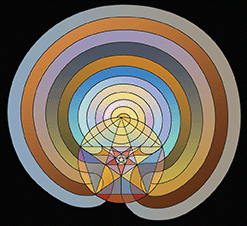
Selected Abstracts
"The Labyrinth of 40 Days and Nights," November 2016, Labyrinth Society Gathering, Houston, Texas
An investigation of the Labyrinth as calendar revealed a
connection to the 40 days and nights when the Pleiades disappear from the heavens to rise
again in the spring. This geocentric view of time is realized in other ancient labyrinths.
Virgil guides Dante through the underworld in a new labyrinth design. The labyrinths'
historical roots are still deeply felt today.

enlarge
2016 Publication of "Labyrinth As Time Art,"
In The Athens Journal of Humanities and the Arts, Vol. 3, number 2, Athens, Greece.
"Labyrinth as Time Art,"Athens Institute for Education and Research, (ATINER).
6th Annual International Conference on Visual and Performing Arts, Athens,
Greece, June 1-4, 2015.
Abstract: This paper proposes that the symbolic image of the classical seven-circuit labyrinth with
its single meandering path to a central goal represents a calendar. This is not a maze with
multiple paths and dead ends. Walking a maze offers too many variations and choices.
A calendar consists of repeatable patterns duplicating the circle dance of the heavens.
By deconstructing the symbol and applying Hesiods' Works and Days, this research attempts
to demonstrate how the labyrinth represented time to the ancients. The labyrinth offers
two expressions of time. One is finite and measurable while the other is infinite and eternal.
When these two concepts of time are unbalanced, heroic journeys into the underworld or searching
the inner psyche are called for. It is this understanding of time that connects the present
day use of the labyrinth as a tool for meditation or as a symbolic referent in works of art.
"Labyrinth of Time and Space," Labyrinth Society Gathering, Vancouver Island, British
Columbia, Canada. 2013. Catalogue Description...
The Labyrinth as Time Art Presenter: Eloise Philpot
Is the labyrinth time art? The meaning of the enigmatic symbol of the labyrinth is illusive,
but there are many clues that offer an educated guess. This research supports the idea of
the labyrinth as a symbol for the year, thus a symbol of regeneration for earth and soul.
This connects its most ancient origins to its use today.
For the last several years, Eloise Philpot has been incorporating the symbol and meaning
of the labyrinth in various works of art. Besides drawings and animations, she has also
created a video art installation that included a walking labyrinth. The academic research
on the labyrinth not only supported her artwork, but also fed her interest in symbol systems
theories, art theory, technology and perception. She has discovered some surprising results
that will be interesting to share with others for comment and feedback.
Selected Abstracts

